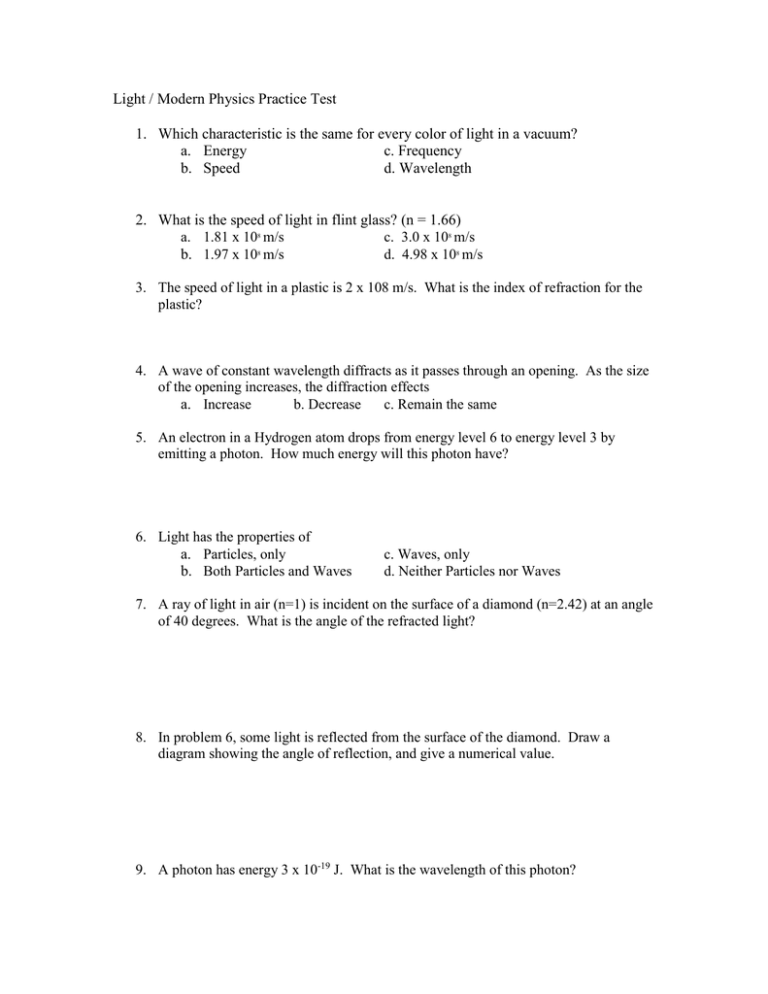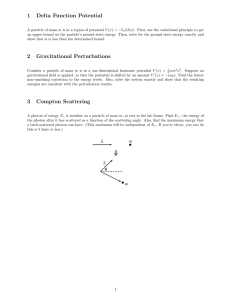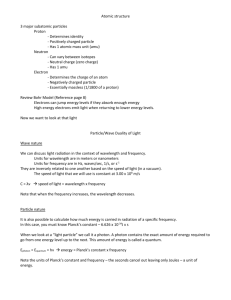Light & Modern Physics Practice Test
advertisement

Light / Modern Physics Practice Test 1. Which characteristic is the same for every color of light in a vacuum? a. Energy c. Frequency b. Speed d. Wavelength 2. What is the speed of light in flint glass? (n = 1.66) a. 1.81 x 108 m/s c. 3.0 x 108 m/s 8 b. 1.97 x 10 m/s d. 4.98 x 108 m/s 3. The speed of light in a plastic is 2 x 108 m/s. What is the index of refraction for the plastic? 4. A wave of constant wavelength diffracts as it passes through an opening. As the size of the opening increases, the diffraction effects a. Increase b. Decrease c. Remain the same 5. An electron in a Hydrogen atom drops from energy level 6 to energy level 3 by emitting a photon. How much energy will this photon have? 6. Light has the properties of a. Particles, only b. Both Particles and Waves c. Waves, only d. Neither Particles nor Waves 7. A ray of light in air (n=1) is incident on the surface of a diamond (n=2.42) at an angle of 40 degrees. What is the angle of the refracted light? 8. In problem 6, some light is reflected from the surface of the diamond. Draw a diagram showing the angle of reflection, and give a numerical value. 9. A photon has energy 3 x 10-19 J. What is the wavelength of this photon? Base your answers to questions 10 through 12 on the passage below. For years, theoretical physicists have been refining a mathematical method called lattice quantum chromodynamics to enable them to predict the masses of particles consisting of various combinations of quarks and antiquarks. They recently used the theory to calculate the mass of the rare Bc particle, consisting of a charm quark and a bottom antiquark. The predicted mass of the Bc particle was about six times the mass of a proton. Shortly after the prediction was made, physicists working at the Fermi National Accelerator Laboratory, Fermilab, were able to measure the mass of the Bc particle experimentally and found it to agree with the theoretical prediction to within a few tenths of a percent. In the experiment, the physicists sent beams of protons and antiprotons moving at 99.999% the speed of light in opposite directions around a ring 1.0 kilometer in radius. The protons and antiprotons were kept in their circular paths by powerful electromagnets. When the protons and antiprotons collided, their energy produced numerous new particles, including the elusive Bc. These results indicate that lattice quantum chromodynamics is a powerful tool not only for confirming the masses of existing particles, but also for predicting the masses of particles that have yet to be discovered in the laboratory. 10. Identify the class of matter to which the Bc particle belongs. 11. Determine both the sign and the magnitude of the charge of the Bc particle in elementary charges. 12. Explain how it is possible for a colliding proton and antiproton to produce a particle with six times the mass of either. 13. An electromagnetic band radio signal could have a frequency of a. 0.005 m c. 500 m b. 5 m d. 5,000,000 m 14. The total conversion of 1 kilogram of mass into energy would yield how much energy? 15. A light source emits a series of photons. As the frequency of the photons increases, what happens to the Energy and Wavelength of the light? 16. Which of the following baryons is neutral? a. uud c. css b. udc d. bbb 17. A hydrogen atom absorbs a photon, and the electron moves from level 2 to level 4. What is the energy of the photon in eV? 18. What is the energy of the photon in 17 in Joules? 19. What is the speed of a radio wave in a vacuum? 20. You and a friend are in a pitch dark room, and cannot see anything. Your friend turns on a single white light, and you see that your friend is wearing a blue shirt. Explain what is going on with the light that causes you to see your friend’s shirt as blue. 21. Radio waves diffract around buildings more than light waves do because, compared to light waves, radio waves a. Move faster b. Move slower c. Have a higher frequency d. Have a higher wavelength 22. The electron neutrino, the muon neutrino, and the tau neutrino are all a. Leptons b. Hadrons c. Baryons d. Mesons 23. When light goes from a low index of refraction material into a high index of refraction material, it bends a. Toward the normal b. Away from the normal c. It depends on the exact angle




